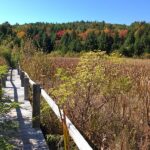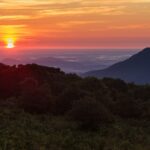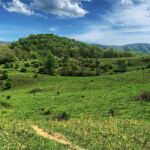Hiking with the Seasons
Late spring and early fall are the prime hiking time for much of the A.T., but the trail is open year round, and each season has something special to offer.
Spring
Spring is a lovely time to hike, but keep in mind that true spring weather doesn’t reach the high mountaintops and ridges of the Appalachian Trail until mid-April or May–or even later in northern New England. The entire A.T. is typically still in the grips of winter during the traditional “spring break” period in March and early April. Once spring does arrive, though, it can be a glorious time to hike, with wildflowers in bloom, and more extensive views until leaves fill in.
Tip for Vermont, New Hampshire, and Maine– Avoid “Mud Season” during April and May.

Summer
Summer can be hot and humid, so starting early in the day when it’s cooler and before possible afternoon thundershowers is a good strategy. However, summer is prime time for hiking in northern New England. In Vermont, June is the earliest recommended time, especially at higher elevations. In Maine and New Hampshire, good hiking conditions don’t start until July; August can be even better in these northern states, with fewer bugs, but trails do tend to be more crowded.

Fall
Fall is a great time to hike, when temperatures cool and autumn colors start to show. September is quite uncrowded in many places. October is the prime month for fall colors, but cold temperatures and snow is a possibility at high elevations in the South by the end of October. The first snows often fall at higher elevations in New Hampshire and Maine in September.
Late fall on a warm day can offer a nice hike with extra views when leaves are off the trees, but be careful of fresh leaves and acorns on the ground. Also be prepared for hunting season, when wearing florescent orange and taking other measures is a must.

Winter
Winter can be beautiful, with the clearest skies of the entire year; many views open up that are obscured in summer by the Trail’s verdant forests. Bugs are gone, and solitude is much easier to come by. But hiking in winter requires extra care, precautions and planning, and gear. Any part of the A.T. can receive snow or ice from November into early April, earlier and later at high elevations in the South and in New England. Remember that daylight hours are greatly reduced, too.

Tip for Any Season
Elevation has a huge impact on temperature and weather
Elevation also affects fall foliage and spring green-up. For example, the high peaks of the Great Smoky Mountains National Park in Tennessee and North Carolina often have weather systems more like New England than the valleys below them. More snow falls on Kuwohi, formerly called Clingmans Dome, in Tennessee than any point on the Appalachian Trail north to Connecticut.
Day of the Week
If you’re doing a popular hike, weekends, especially Saturday, will likely be very busy when the weather is good or fall color is at its peak. Parking lots could be full by mid-morning.
If you’re looking for quiet and solitude, weekdays are a better choice. Holiday weekends can be super crowded, so that’s a good time to look for a lesser-known hike.

Time of Day
Morning is a great time to hike. You don’t have to worry about getting a parking space and there’s less chance you’ll run out of daylight. Many hikes on the A.T. start by going uphill, so you can do the workout part of the hike while it’s cooler.
In winter or shoulder seasons, mornings may be chilly, but you’ll usually warm up quickly when heading uphill. It’s especially important to start early in winter as daylight hours are short.



